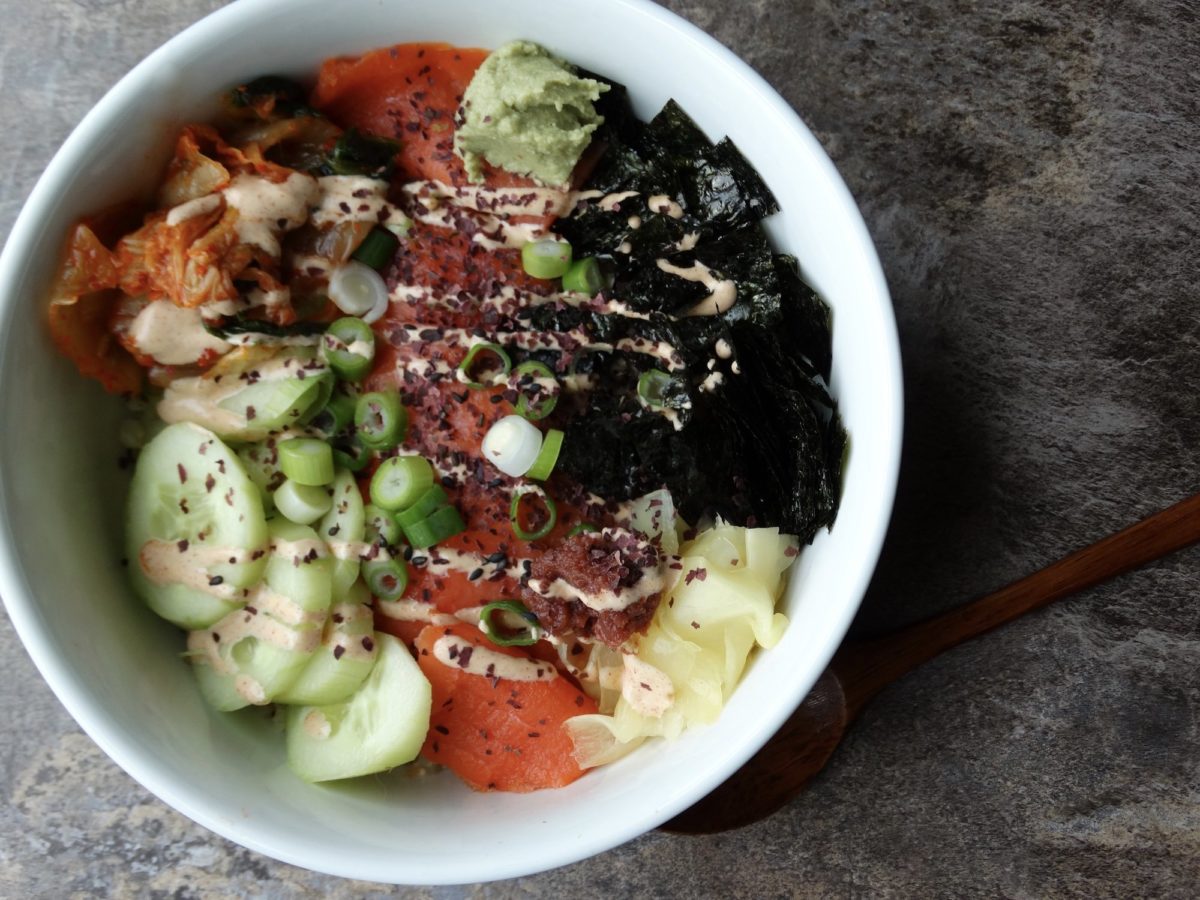Craving sushi but watching your carb intake? Imagine a vibrant bowl brimming with colorful vegetables, succulent protein, and a tantalizing sauce, all without the carb overload. This isn’t a dream; it’s the delicious reality of low-carb sushi bowls. We’ll guide you through creating these healthy and satisfying meals, exploring creative rice alternatives, protein-packed additions, and flavorful low-carb sauces that will leave your taste buds singing.
From the satisfying crunch of cauliflower rice to the delicate sweetness of shrimp and the zesty kick of a homemade low-carb dressing, we’ll uncover the secrets to crafting visually stunning and nutritionally balanced sushi bowls that are as good for you as they are delicious. Prepare to embark on a culinary journey that redefines the art of healthy eating.
Low-Carb Sushi Bowls Sauces & Dressings

Creating flavorful and satisfying low-carb sushi bowls hinges on the right sauces and dressings. These condiments not only enhance the taste but also add a textural element that elevates the overall dining experience. The following recipes focus on low-carb alternatives that deliver bold flavors without compromising your dietary goals.
Three Unique Low-Carb Sauce Recipes
The key to delicious low-carb sushi bowls lies in exploring diverse flavor profiles. These three recipes offer a range of tastes, from tangy and sweet to savory and umami-rich.
- Spicy Sesame Ginger Sauce: Imagine a vibrant, crimson sauce coating your perfectly arranged sushi bowl ingredients. This sauce starts with a base of 2 tablespoons of low-sodium coconut aminos, providing a salty-savory foundation. Then, whisk in 1 tablespoon of sesame oil, adding a nutty aroma and richness. A teaspoon of grated fresh ginger lends a subtle warmth and a hint of spice. Finally, a dash of sriracha or your favorite chili garlic sauce adds a fiery kick. The final touch is a squeeze of lime juice for brightness and acidity, balancing the richness of the sesame oil.
- Sweet and Tangy Ponzu Alternative: This sauce mimics the classic Japanese ponzu but without the added sugars. Combine 2 tablespoons of rice vinegar (check the label for low-sugar options or use apple cider vinegar), 1 tablespoon of low-sodium coconut aminos, and 1 tablespoon of freshly squeezed lime juice. The lime juice adds a zesty tang, while the rice vinegar provides a subtle sweetness and acidity. For a touch of sweetness, add a small pinch of stevia or erythritol. A teaspoon of finely grated lemon zest adds brightness and complexity.
- Creamy Avocado Cilantro Dressing: This creamy, vibrant green dressing offers a refreshing contrast to the savory elements of the sushi bowl. Blend one ripe avocado until smooth. Slowly incorporate 2 tablespoons of low-fat Greek yogurt (or unsweetened almond milk for a vegan option), a handful of fresh cilantro, the juice of half a lime, a pinch of salt, and a pinch of garlic powder. The result is a luscious, herbaceous sauce that coats each ingredient beautifully.
Comparison of Soy Sauce, Tamari, and Coconut Aminos
Soy sauce, tamari, and coconut aminos represent popular low-carb alternatives, each offering a unique flavor profile and nutritional composition.
| Sauce | Flavor Profile | Nutritional Considerations |
|---|---|---|
| Soy Sauce | Salty, umami, often slightly sweet | High in sodium, contains gluten (unless specifically labeled gluten-free) |
| Tamari | Similar to soy sauce, but richer, nuttier flavor | High in sodium, naturally gluten-free |
| Coconut Aminos | Savory, slightly sweet, with a subtle coconut undertone | Lower in sodium than soy sauce and tamari, gluten-free, often contains less sodium |
Low-Carb Mayonnaise-Based Dressing
A mayonnaise-based dressing adds a creamy richness to sushi bowls. The base of mayonnaise provides a smooth texture and a blank canvas for customization.
A simple low-carb mayonnaise-based dressing can be created by combining 2 tablespoons of mayonnaise with 1 tablespoon of rice vinegar, a teaspoon of Dijon mustard, and a pinch of salt and pepper.
This basic recipe can be enhanced with various additions. For instance, adding a teaspoon of wasabi paste delivers a pungent kick, while finely chopped chives or green onions add freshness and visual appeal. A dash of sesame oil contributes a nutty aroma and a subtle richness. Experiment with different herbs and spices to tailor the dressing to your preferred taste.
Creating low-carb sushi bowls is a delightful adventure in culinary creativity. By mastering the art of substituting traditional rice with healthy alternatives, selecting lean protein sources, and incorporating a vibrant array of low-carb vegetables and flavorful sauces, you unlock a world of delicious possibilities. Each bowl becomes a personalized masterpiece, a testament to your culinary prowess and a celebration of healthy, satisfying eating. So, gather your ingredients, unleash your inner chef, and prepare to be amazed by the vibrant flavors and textures awaiting you.
Detailed FAQs
Can I use pre-made cauliflower rice?
Yes, pre-made cauliflower rice is a convenient option, but making your own allows for better texture control. Look for brands that minimize added ingredients.
Are there vegan protein options for low-carb sushi bowls?
Absolutely! Tofu, tempeh, and edamame are excellent vegan protein sources that add both flavor and texture to your low-carb sushi bowls.
How can I store leftover low-carb sushi bowls?
Store leftover bowls in an airtight container in the refrigerator for up to 3 days. It’s best to keep the rice and protein separate from the sauce to prevent the rice from becoming soggy.
What are some good low-carb sweeteners to use in the sauces?
Stevia, erythritol, and monk fruit are excellent low-carb sweetener options that won’t significantly impact your carb count.


